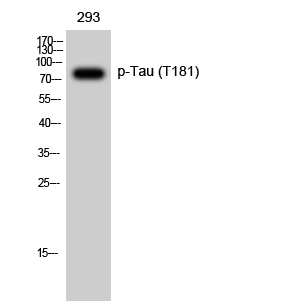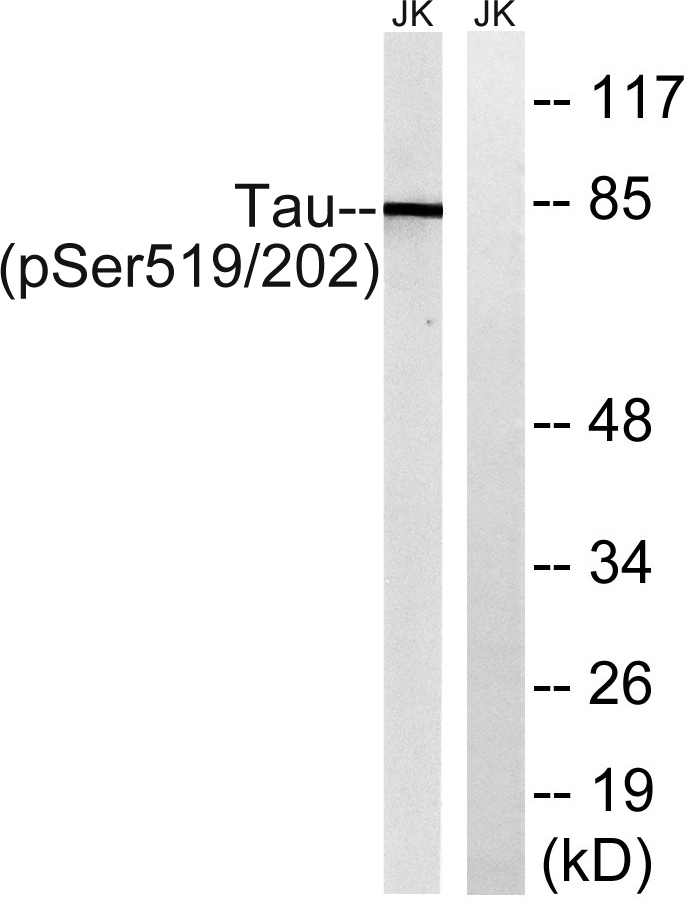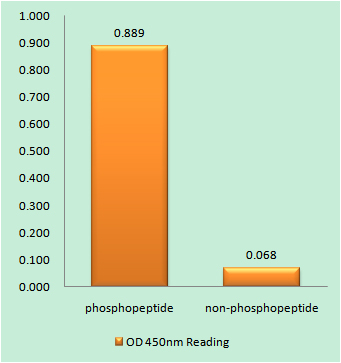Tau (phospho Ser516/199) Polyclonal Antibody
- Catalog No.:YP0498
- Applications:WB;ELISA
- Reactivity:Human;Mouse;Rat
- Target:
- Tau
- Fields:
- >>MAPK signaling pathway;>>Alzheimer disease;>>Parkinson disease;>>Pathways of neurodegeneration - multiple diseases
- Gene Name:
- MAPT
- Protein Name:
- Microtubule-associated protein tau
- Human Gene Id:
- 4137
- Human Swiss Prot No:
- P10636
- Mouse Gene Id:
- 17762
- Mouse Swiss Prot No:
- P10637
- Rat Swiss Prot No:
- P19332
- Immunogen:
- The antiserum was produced against synthesized peptide derived from human Tau around the phosphorylation site of Ser516 or 199. AA range:166-215
- Specificity:
- Phospho-Tau (S516/199) Polyclonal Antibody detects endogenous levels of Tau protein only when phosphorylated at S516/199.
- Formulation:
- Liquid in PBS containing 50% glycerol, 0.5% BSA and 0.02% sodium azide.
- Source:
- Polyclonal, Rabbit,IgG
- Dilution:
- WB 1:500 - 1:2000. ELISA: 1:40000. Not yet tested in other applications.
- Purification:
- The antibody was affinity-purified from rabbit antiserum by affinity-chromatography using epitope-specific immunogen.
- Concentration:
- 1 mg/ml
- Storage Stability:
- -15°C to -25°C/1 year(Do not lower than -25°C)
- Other Name:
- MAPT;MAPTL;MTBT1;TAU;Microtubule-associated protein tau;Neurofibrillary tangle protein;Paired helical filament-tau;PHF-tau
- Observed Band(KD):
- 50-85kD
- Background:
- This gene encodes the microtubule-associated protein tau (MAPT) whose transcript undergoes complex, regulated alternative splicing, giving rise to several mRNA species. MAPT transcripts are differentially expressed in the nervous system, depending on stage of neuronal maturation and neuron type. MAPT gene mutations have been associated with several neurodegenerative disorders such as Alzheimer's disease, Pick's disease, frontotemporal dementia, cortico-basal degeneration and progressive supranuclear palsy. [provided by RefSeq, Jul 2008],
- Function:
- alternative products:Additional isoforms seem to exist. Isoforms differ from each other by the presence or absence of up to 5 of the 15 exons. One of these optional exons contains the additional tau/MAP repeat,developmental stage:Four-repeat (type II) tau is expressed in an adult-specific manner and is not found in fetal brain, whereas three-repeat (type I) tau is found in both adult and fetal brain.,disease:Defects in MAPT are a cause of corticobasal degeneration (CBD). It is marked by extrapyramidal signs and apraxia and can be associated with memory loss. Neuropathologic features may overlap Alzheimer disease, progressive supranuclear palsy, and Parkinson disease.,disease:Defects in MAPT are a cause of frontotemporal dementia and parkinsonism linked to chromosome 17 (FTDP17) [MIM:600274, 172700]; also called frontotemporal dementia (FTD) or historically termed Pick complex. This form
- Subcellular Location:
- Cytoplasm, cytosol . Cell membrane ; Peripheral membrane protein ; Cytoplasmic side . Cytoplasm, cytoskeleton . Cell projection, axon . Cell projection, dendrite . Secreted . Mostly found in the axons of neurons, in the cytosol and in association with plasma membrane components (PubMed:10747907). Can be secreted; the secretion is dependent on protein unfolding and facilitated by the cargo receptor TMED10; it results in protein translocation from the cytoplasm into the ERGIC (endoplasmic reticulum-Golgi intermediate compartment) followed by vesicle entry and secretion (PubMed:32272059). .
- Expression:
- Expressed in neurons. Isoform PNS-tau is expressed in the peripheral nervous system while the others are expressed in the central nervous system.
- June 19-2018
- WESTERN IMMUNOBLOTTING PROTOCOL
- June 19-2018
- IMMUNOHISTOCHEMISTRY-PARAFFIN PROTOCOL
- June 19-2018
- IMMUNOFLUORESCENCE PROTOCOL
- September 08-2020
- FLOW-CYTOMEYRT-PROTOCOL
- May 20-2022
- Cell-Based ELISA│解您多样本WB检测之困扰
- July 13-2018
- CELL-BASED-ELISA-PROTOCOL-FOR-ACETYL-PROTEIN
- July 13-2018
- CELL-BASED-ELISA-PROTOCOL-FOR-PHOSPHO-PROTEIN
- July 13-2018
- Antibody-FAQs
- Products Images

- Western blot analysis of Tau (Phospho-Ser516/199) Antibody. The lane on the right is blocked with the Tau (Phospho-Ser516/199) peptide.



